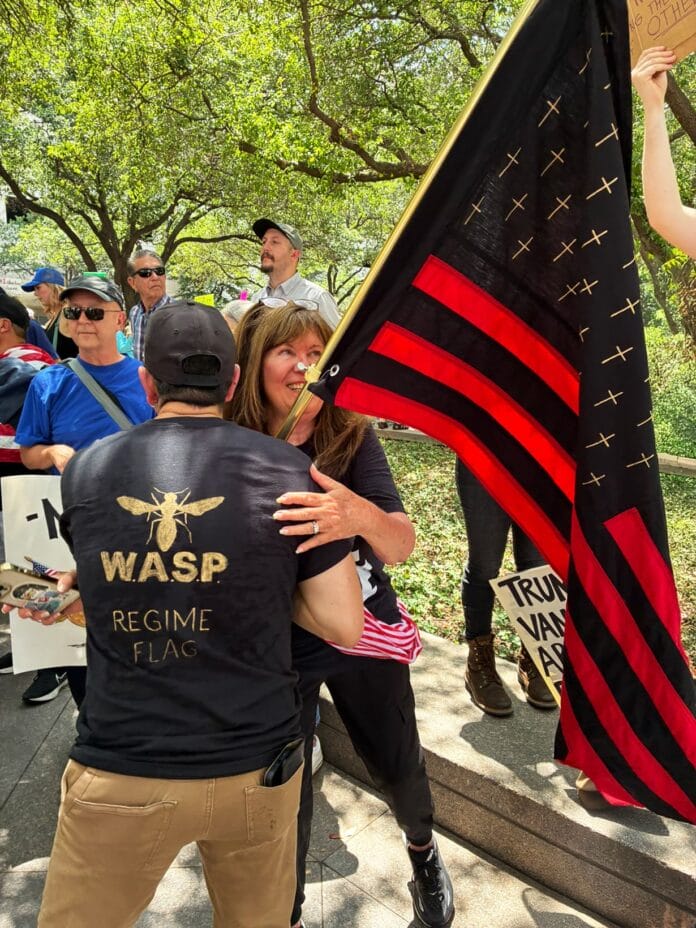In “WASP Regime Flag – A Great Country”, Colombian-American artist Bernardo Vallarino doesn’t merely challenge the viewer—he indicts an ideology. The piece is one of ten provocative flags that conflate American and Nazi iconography to uncover uncomfortable truths about the undercurrents of white supremacy, militarism, and Christian nationalism in contemporary U.S. society. Through carefully chosen symbols—gold crosses, eagles, stars, and the titular wasps—Vallarino weaponizes aesthetics to expose how historical horrors can be repackaged in patriotic disguise.
This is not art for passive observation. It’s a warning.
The Flag as a Symbol of Power and Myth
In “WASP Regime Flag – A Great Country”, Vallarino employs the flag—a universal emblem of identity, allegiance, and pride—as both canvas and critique. Flags typically function to unite under shared values, but here they unravel those very notions. By fusing U.S. and Nazi military symbols, Vallarino highlights the ideological overlaps between the two: systemic racism, militant nationalism, and religious supremacy.
The term “WASP”—an acronym for White Anglo-Saxon Protestant—has long denoted a dominant social class in America, historically associated with privilege, political power, and exclusionary values. In this flag, Vallarino literalizes the term by incorporating actual wasp imagery, a symbol often associated with aggression, territoriality, and predatory behavior. By replacing stars and swastikas with gold crosses and wasps, the work speaks to a continuity of ideology rather than a rupture between past and present.
Aesthetic Subversion and Ethical Confrontation
Visually, the piece draws on the rigid geometry and bold palette of traditional flags, enhancing its formal familiarity—red, white, and black tones echoing both Nazi aesthetics and American military garb. But it’s the alterations that jolt the viewer into awareness: gold crosses gleam where stars once stood, suggesting not salvation but dominance. The wasp, positioned like a crest or seal, commands attention as an emblem of warning rather than honor.
The blending of American and fascist imagery is not an act of historical comparison alone—it’s a form of moral interrogation. Vallarino asks: How close are we, really, to the ideologies we claim to have vanquished? Can a democracy, dressed in freedom’s language, still harbor the same patterns of dehumanization and violence?
Beyond Satire: Art as Ethical Weapon
What makes Vallarino’s flag series particularly powerful is its refusal to function as parody or political cartoon. These are not exaggerations meant for comic relief or one-dimensional critique. Instead, each flag operates as a symbol of real and present danger. In the words of the artist, these are “not historical artifacts, but warnings.” They remind viewers that ideologies never truly disappear—they mutate, adapt, and often re-emerge draped in the familiar rhetoric of patriotism, religion, and national pride.
Here, the visual language of allegiance is turned against itself. The sacred becomes profane, the proud becomes sinister, and the comfortable becomes complicit. In doing so, Vallarino refuses to let the viewer look away.
About the Artist: Bernardo Vallarino
Born in Colombia and based in the U.S., Bernardo Vallarino is a mixed-media sculptor and installation artist known for his searing explorations of geopolitical violence and human suffering. His practice draws heavily from history, media narratives, and entomology—the study of insects—creating symbolic works that are as intellectually charged as they are emotionally resonant.
Vallarino holds a BFA from Texas Christian University and an MFA from Texas Woman’s University. His academic and curatorial work runs parallel to his studio practice. He is a fellow of the National Association of Latino Arts and Cultures (NALAC), the coordinator of the Fort Worth Art Collective, and serves as a city art commissioner. His work has been exhibited widely across Texas, Oklahoma, and internationally in England and Spain, with notable showings at the Nasher Sculpture Center, Meadows Museum, Arlington Museum of Art, Amarillo Museum of Art, and more.
The Personal as Political, the Symbolic as Tactical
Vallarino’s choice of materials and motifs is never arbitrary. His interest in entomology frequently appears in his work—bees, ants, and here, wasps, are metaphors for systemic behavior, collective violence, and social organization. In this flag series, the wasp becomes more than an insect; it is a metaphor for silent, creeping aggression masked as order and structure.
His artistic vocabulary is shaped by personal experience as much as scholarly research. Growing up between two cultures, and witnessing political instability in both, Vallarino is acutely aware of how ideology takes root—how symbols can become weapons, and how belief systems can justify inhumanity. This dual perspective allows him to see the cracks in the dominant narratives of both countries and critique them with clarity and precision.
Conclusion: A Visual Call to Wakefulness
“WASP Regime Flag – A Great Country” confronts a painful and urgent question: What if patriotism is not always a virtue? What if it can be twisted into something dangerous?
Through this powerful piece, Bernardo Vallarino asks audiences to question the symbols they trust, the histories they inherit, and the ideologies they unknowingly uphold. In doing so, he reclaims the flag—not as a symbol of loyalty, but as a tool for critique. His work is not merely about seeing—it’s about reckoning.
As nationalism rises around the world, Vallarino’s flags are timely reminders that the past is never truly past. Sometimes, it’s right in front of us, flying high in plain sight.


